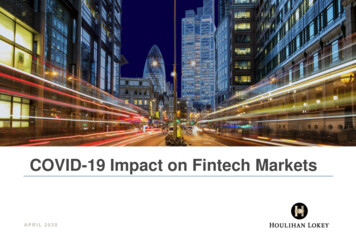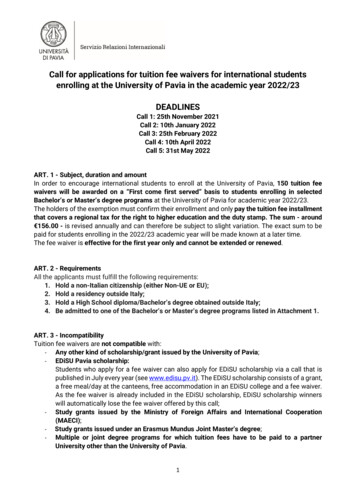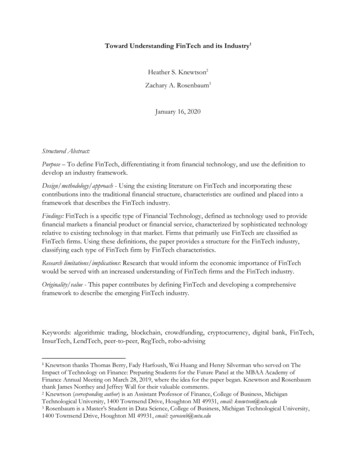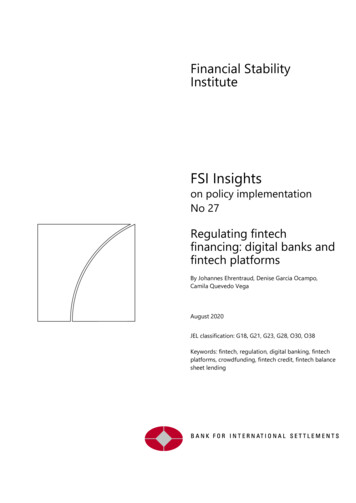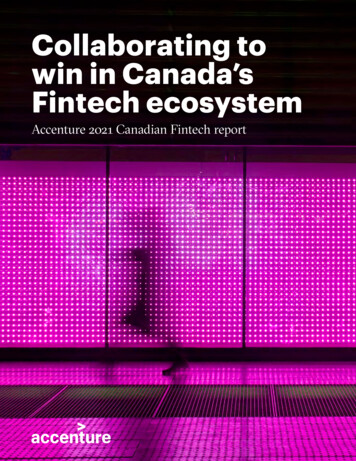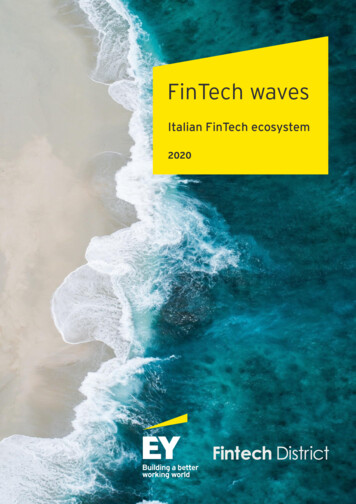
Transcription
FinTech wavesItalian FinTech ecosystem2020FinTech waves – Italian FinTech Ecosystem 20201
ContentsResearch goals and methods3Executive summary5Update post COVID-198Financial services trend10Global trends11Europe trends13Italian trends16The FinTech market26FinTech environment27Global trends29Europe trends39Italian trends453Italian FinTech ecosystem534The investor market835EY teams and Fintech District point of view – conclusion1136Appendix12312FinTech waves – Italian FinTech Ecosystem 20202
Research goals and methodsFinTech’s gaining momentum. Let’s start with two simple facts about FinTech growth. First, if we look atthe number of FinTech startups in Italy, there were 16 startups in 2011, 199 in 2015 and a total of 345startups in 2019. Second, looking at the academic relevance, if we had searched the term «FinTech» on GoogleScholar, we would have obtained 2,060 results in 2011, 4,630 results in 2015 and 18,300 results in 2020.Our goals. First of all, the aim of our research is to clarify the definitions of “FinTech” provided by differentplayers over time. Our purpose is to provide a unique internal point of view on the Italian FinTech ecosystem byanalyzing three different areas: Corporate Finance, People and Skills, Risk and Compliance. Moreover, at theend of this research, we will present our point of view on the current state of the Italian FinTech ecosystem andhow it connects with the market trends of the Financial Services sectors.A complete and exhaustive research. Our research starts with the analysis of the Financial Servicestrends from a Global and European perspective, followed by an analysis of the Italian market. Further on, ananalysis of the FinTech market, both as a world-wide phenomenon and with an emphasis on what distinguishesthe Italian FinTechs, is provided. Additionally, our research presents a focus on the investor market, analyzingM&A and FinTech. Finally, we conducted a specific survey of the Italian FinTechs started between 2011 and2019, in order to explore and navigate this emerging ecosystem.Scope of FinTech reportFinancial Services Trends(economic, financial and business)FinTech chsEuropeItalyItalyItalian SurveyFinTech waves – Italian FinTech Ecosystem 20203
Research goals and methodsSetting the trends and giving our point of view. The outcome of our survey is based on theinformation provided by our analysis of Financial Services, the FinTech environment and M&A, in order to findout and explore the future trends of FinTech in Italy. Moreover, our survey provides insights about the ItalianFinTech ecosystem, its current situation and what we expect for the future.Unity is strength. This research has been made by combining the knowledge of the EY teams dedicated toFinancial Services and FinTech industries with the FinTech District’s presence in the FinTech community and itsunique viewpoint of the ecosystem. Furthermore, our research and analysis are based on several reliablesources from the market and academics.Responses from the FinTechs. Plenty of research about the Italian FinTech ecosystem are available in themarket, but very few of them have included a survey with responses directly from the FinTech startups.Consequently, one of the most distinctive elements of our research is our questionnaire submitted to the ItalianFinTechs, from which we obtained precious insights about three different areas - Corporate Finance, People andSkills, Risk and Compliance. This is the added value of this publication which makes it unique in the market.COVID-19 out of a clear blue sky. The Coronavirus pandemic has shocked the entire financial ecosystem.It has forced businesses to rethink their operating models, and even the companies that were reluctant tochange had to act fast to face the challenge of COVID-19. Process digitization has suddenly accelerated.FinTech services such as digital payments and alternative lending have had a remarkable boost. TheCoronavirus pandemic has represented both a challenge and an opportunity for FinTech. In this document, wedive into the impact that the COVID-19 outbreak has had on the FinTech ecosystem.FinTech waves – Italian FinTech Ecosystem 20204
Executive summary““The FinTech ecosystem will have room forrelevant growth only by applying a coopetitionapproach within Financial Services to leverageon open finance models with all players.The quick recent growth of the Italian Fintechecosystem should put it on the radar of investorswho wish to get the best opportunities early.Entrepreneurs with experience and track recordsare attracting talents, and it is just a matter oftime for investments to follow.Andrea Ferretti,EY Partner, Markets & Business Development Leader forFinancial Services and FinTech Leader in ItalyAlessandro Longoni,Head of Fintech DistrictFinancial Services are focusing on cost optimization and operational efficiency. and thedigital transformation?Financial players are facing new challenges from an array of non-traditional competitors, all while meetinggreater demands for trust and transparency. Customers are changing; their needs and expectations areevolving, needing more customized and user-friendly services. Banks are consolidating, merging together tohelp reduce overcapacity, to enhance profitability and create synergies. The insurance industry remains stuckin low-growth mode because of low interest rates and weak economic indicators. Wealth Asset Management israpidly changing because customers require holistically managed services. In this context, digital transformationcould be a strategic lever to enable change.Italian trends are almost aligned with other European countries facing the major issues ofNon-Performing Loans (NPL) management, recovery of profitability and IT system evolutionThe banking sector in Italy is in a rationalization and consolidation phase, mostly created by regulators.Banks are focusing on increasing efficiencies and revenues by renewing their operating model, reducing NPLexposition and digitalizing processes. However, modernization of legacy systems remains the first constraint indigital transformation activities. Insurers and Wealth and Asset Managers continue to grapple with low interestrates, rising competition, technological innovation and regulatory shifts.FinTech, the new phenomenon disrupting Financial ServicesThe FinTech industry is characterized by organizations that combine innovative business models and technologyto enable, enhance and disrupt Financial Services. Through digital innovation FinTech companies can offerservices that are transparent, accessible, effortless and cost-cutting, tailoring products to the evolvingexpectations of new customers. New regulations such as the European PSD2 allow FinTech startups to flourish,boosted by their API-driven architectures which facilitate the compliance to the emerging Open Banking system.Global investments in FinTechfirms (2016-2019) reach US 110bNorth America43 unicornsUS 156.8bSouth America3 unicornsUS 12bAsia15 unicornsUS 223.5bEurope14 unicornsUS 32.65bOceania2 unicornsUS 2.4bFinTech waves – Italian FinTech Ecosystem 20205
Executive summaryAccording to our analysis, the Italian FinTech ecosystem is heterogenous, small in size butwith high potentialFrom the survey we have conducted, most startups are in the intermediate stages of growth and have raisedless than 1m. Analysis does not show a positive correlation between the year of foundation and the growthstage. FinTechs usually have small teams, with a median of 8.5 employees per startup. The top 20 FinTechs byfunds raised have on average 1.8 founders per startup with an average age of 46 years per founder and thatthey are 100% male. 56% of the team members have an average age of under 32 years. From the hiringperspective, the most requested profiles, software and business developers, are also those considered as scarcein the market. With regards to the Risk and Compliance function, 74% of the startups fill the role and 51% spendless than 50k annually. The Regulatory Sandbox in Italy is considered important but it is not consideredfundamental for foreign startups willing to enter the market.Break-down of Italian FinTechs byclassification3%2%2% 2% 1%21%Crowdfunding (71)DNA, ML, AI (35)Smart Payments & Money Transfers (34)Lending (30)InsurTech (28)Crypto (21)WealthTech (19)Cybersecurity (18)Capital Markets & Trading (16)Invoice & Tax Management (16)PFM (12)Chatbot (11)Open Banking Services/API (11)Neo Banks (7)Blockchain (6)RegTech (6)3%3%5%5%10%5%Data Management (4)6%10%6%8%The 5 largest segments represent 58% of Italian startups9%Italian landscape:Main investment sources:74% FinTechBusinessAngelsTechFin26% 700kmedian fundingper startupLombardyhas thehighestpresenceofstartups81%6.73 xTechFin 4.34 xB2B 9.37 xB2C 4.10 xFinTech PersonalresourcesForof startups,male employeesaccount for more thanCompany value multiplier*:* Ratio between post money valuation andfunds raisedGDPR and PSD253%50% of the wholeteamof startups have lessthan 10 employeesFinTech waves – Italian FinTech Ecosystem 20206are the regulations withthe highest impact.92% are in favor of aRegulatory Sandbox
Executive summaryFinTech received most of the investment across Europe. The Italian gap is narrowingTrends showed that investors' interest on early-stage startups shifted towards mid- and late-stage companies.In 2019, investments in later stage FinTechs reached the highest annual share of deals of the period 20162019, while early stage financing declined to a 12-quarter low in 4Q19. The FinTech industry received most ofthe investments across Europe over the period 2016-2019, collecting 20% of the capital invested in the region.Although investments in the Italian FinTech ecosystem still lag behind other European and global environments,that gap started to narrow in recent years. Funding to Italian FinTech startups grew at a CAGR of over 60% from2016 to 2019. From our survey of the Italian landscape it emerges that the median funding per startup is 700k, FinTechs have collected more than TechFins and have, on average, a higher annual turnover thanTechFins. The main investment sources are business angels and personal resources. Institutional Investorsmostly invest in B2B business model (startups offering products/services to businesses, e.g., lending for SMEs)and they prefer investing in FinTech rather than TechFin. M&A and IPO are the most targeted exit strategies.SMEs’ services, Cybersecurity, RegTech. WealthTech, Open Banking and collaboration withfinancial institutions are the future of FinTech.The Italian FinTech ecosystem is rapidly growing and it is attracting increasing investments. SMEs, the backboneof the Italian economy, must be better served by banks by leveraging FinTech solutions. Cybersecurity andCyber Insurance are capturing attention boosted by digital transformation. Compliance will continue to play aprimary role in Financial Services, so RegTech will have a fundamental role in the digitalization process.WealthTech, enabled by AI, is the revolution in the Wealth and Asset Management sector. Open Banking must beconsidered as an active opportunity for banks, and collaboration between FinTech and Financial Institutions willbe fundamental for mutual success.Italian FinTech ecosystem matrix DNA, ML, AICrowdfundingWealthTechSmart Payments &Money rityInvoice & sOpen BankingCapital Markets& TradingCryptoPFMBlockchain-Market growth potentialKey:Market presence: no. of startups in the Italian FinTech ecosystemFinTech waves – Italian FinTech Ecosystem 20207
Update post COVID-19COVID-19 pandemic. During the editing phase of this research, the COVID-19 (Coronavirus) pandemicchanged the world: governments have imposed lockdowns, working from home has become the norm andpeople must “socially-distance”. Almost every sector has been strongly impacted by the COVID-19 outbreakwith severe consequences. Financial Services sectors are definitely included.Radical changes and concerns in the Financial Services sectors. The banking sector, due to theCoronavirus, has experienced rapid and unexpected changes. Because of the imposed social-distancing and thelockdowns, bank branches lost their strategic function of being close to clients and the trend of decreasing thenumber of branches has surged. Moreover, the outbreak has strongly impacted SMEs and their revenue, increating an increased risk of Non-Performing Loans (NPLs). On the other hand, bureaucracy in getting credithas been streamlined, governments have offered state aid to SMEs through financial institutions anddigitalization initiatives had a significative boost. For the insurance sector, Coronavirus can be considered a“black swan”, a totally unexpected and unpredictable event. Travel, event, business interruption, credit andhealth coverage have been the areas most affected, although underwritings in these categories are expected torise in the future because of a greater attention and sensibility to these risks. Wealth and Asset managementcompanies experienced turbulent times with clients’ concerns about their investment portfolios. Despite aninitial phase of strong uncertainty, economic recession brings new investments and opportunities. Wealth andAsset Managers are rebalancing their portfolios to better address this situation and seize new opportunities.Resiliency. Despite the great changes in Financial Services due to the COVID-19 pandemic, the sector macrotrends that have been identified in this research will remain relevant. Moreover, the increase of digitaltransformation processes and initiatives will continue to rise, riding the trend that has already started. TheCOVID-19 situation has being a catalyst, giving a boost to the entire renewal process.Seize the opportunities. The COVID-19 pandemic has re-shuffled the market, accelerating digitaltransformation, innovation and remote services. FinTech solutions typically leverage on these three elements.And so this pandemic on the one hand has put the FinTech startups under economic pressure while, on theother hand, has boosted the adoption of their services. The FinTech market, and in particular the Italianlandscape, therefore has not been strongly negatively impacted by COVID-19. Some segments have evenincreased their operativity, adoption and revenues. According to a survey conducted by the FinTech andInsurTech Observatory of the Politecnico di Milano, 54% of the Italian FinTech startups have not been adverselyaffected and 19% have been positively impacted by the COVID-19 situation. These trends are confirmed by thesurvey made by the FinTech District. The survey shows that in some segments such as smart payment andmoney transfer, lending, insurtech and e-commerce related, the pandemic has brought a positive impact onbusiness.FinTech waves – Italian FinTech Ecosystem 20208
Update post COVID-19Agility and flexibility are the keys. Governments’ actions to contain the outbreak of COVID-19 has forcedcompanies and their employees to adopt work from home policies and to rethink their operating models andtheir products. FinTech, and more broadly speaking, startups, make agility and flexibility their hallmark.Innovative startups, such as FinTechs, are used to leverage digital technologies and capabilities to address theirdaily jobs. Moreover, their business and operating models are based on agility and flexibility in terms ofproduct/service offerings. Because of their intrinsic characteristics, FinTechs are ready to better address thenew challenges and difficulties that the pandemic brought.Our results and identified trends do not change. COVID-19 has had a big impact on the overalleconomy and on the FinTech ecosystem. However, we do not see any relevant changes in the survey’s outcomeand on what we expect for the future. In the short-term though, some shifts may occur, especially from theinvestor side. We have observed a slowdown of new transactions and a conservative tendency on the investorside. Investors are generally more focused on monitoring their existing portfolios instead of seeking newopportunities. In the medium-term, we expect a boost of investments in FinTech, due to the new digitalizationchallenges and the potential higher liquidity available for institutional investors. With respect to crisismanagement, we foresee a review of business plans involving adjusted predictions of cash flow and fundingnecessities. And, at least for the short-term, a potential stronger appetite to buy in terms of collaborationmodels between incumbents and FinTech, temporarily setting aside more strategic and comprehensiveapproaches such as partnership or acceleration programs.FinTech waves – Italian FinTech Ecosystem 20209
Chapter 1Financial services trendGlobal / European / ItalianFinTech waves – Italian FinTech Ecosystem 202010
Global trendsAmid sweeping regulatory changes, today’s Financial Servicesinstitutions are focusing on digital transformation, convergenceand disruption from an array of non traditional competitors - allwhile meeting greater demands for trust and transparency.Banking and Capital Markets The global banking sector is considerably healthier nowthan it was 10 years ago at the start of the globalfinancial crisis, even though 2019 had the lowestgrowth in a decade. In the BCM sector we see the followingtrends: Customer expectations and behaviors arechanging and constantly evolving. Banks are facing an increase in competition fromnew market entrants such as FinTech and TechFin. Banks are investing in new technologies tostrengthen their competitive positioning and buildmarket share over the coming three years and tomitigate cyber threats.Neo-banks such as Kakao Bank, Monzo and Revolutare winning over the millennials by offering easyand userfriendly banking applications.Big tech players such as Google, Amazon,Facebook and Apple are taking the first steps intoFinancial Services by acquiring banking licenses.Banks are offering additional services and forgingexternal alliances in order to build an ecosystemand therefore strengthen customer engagement.Banks are leveraging data to give a morecustomized and effective offer to their customers.Banks are focusing on risk management activitiesin order to strengthen resilience. The most fearedrisks are cybersecurity, credit and transition todigital strategies.Digital disruption is unevenly distributed. China,for example, passed directly from a rural economyto a digital economy, skipping the stagesexperienced in other developed countries.2020 CRO’s top riskpriorities over thenext 12 ansition to digital strategies8Data privacy4Conduct9Operational resilience5Regulatory implementationSource: EY 2020 Global Banking Outlook ReportFinTech waves – Italian FinTech Ecosystem 20201110Model
Financial services trend - Global trendsInsurance Low interest rates, stagnant growth and the growinglikelihood of a global recession define the challengingeconomic reality for insurers around the world. In the Insurance sector we are observing thefollowing trends: Populations are aging in more developedcountries and birthrates can even have a negativetrend - insurance products are following. Customer expectations are rising and will only gethigher in the near future. Creating unique andpersonalized customer experience has been apriority for many years. Asian insurers have shown the way forward, byquickly delivering innovation to consumers with thehighest expectations for anything concerningdigital and mobile.Insurers need to deeply understand how customerexpectations are changing and leverage therelevant technologies to deliver products, servicesand experiences that match those expectations.Regulations are changing the landscape – MiFIDand similar regulations around transparency andfairness are forcing players to re-think theirassociated strategies, risks and costs.Many Wealth and Asset Management players aredeveloping new capabilities to provide investorswith digital, simple and personalized access tosavings and investment.Cost reduction and efficiency – the ability toautomate processes and reduce costs as well as tostreamline and simplify them has enabled playersto maintain acceptable margins, but has requiredsignificant investment.Evolution and innovation is needed to meetcustomer needs. This includes digital engagementand customer interest in companies making adifference beyond financial ones (i.e.,Environmental, Social and Governance (ESG)).Data and analytics will have a key role in enablingthe personalization of solutions to retail andinstitutional customers.A brief recap of Global Financial Services’trendsAI and blockchain will have a profound impact onthe industry, though the full force of thesetechnologies is a few years out. Internet of Things (IoT) is already starting toenable opportunities for connected insurance andon-demand products (e.g., smart sensors installedon cars). Wealth and Asset ManagementFrom tech-enabled innovation and new marketentrants to intense cost pressures and rising customerexpectations, wealth and asset managementcompanies will likely change more in the next fiveyears than they have in the last 25. The most important trends in the Wealthand Asset Management sector globally are: Customers are changing, their needs andexpectations are evolving needing morecustomized and user-friendly services.Financial Services will aggregate itsecosystem and platforms.Financial Services must innovate and adopttechnological solutions in order to bettermeet customer needs.Regulation is rapidly changing the market,protecting customers and enhancingtransparency.Cost reduction and efficiency will still betop priorities.SourcesDemographics among aging populations in somecountries result in a greater need for income inretirement. Responsibility is falling on individualsas it is shifting away from the institutions. EY Market Intelligence McKinsey Oliver Wyman EY - IIF global bank risk management survey EY 2020 Global Banking Outlook ReportFinTech waves – Italian FinTech Ecosystem 202012
European trendsEuropean financial institutions are turning from regulation togrowth and innovation, especially in the cybersecurity anddigital transformation programs. Nevertheless, financialinstitutions are consolidating and reducing costs due topolitical uncertainty.Banking and Capital MarketsFrom a regulatory perspective, from March 2019the Basel III capital standards have becomeeffective, with the aim of strengthening bankcapital requirements, but also possibly impactingthe profitability of corporate banks. Moreover, in2018 PSD2 and GDPR both were introduced ascomprehensive sets of legislation focusing onconsumer data.Business priorities for European banks are turningfrom regulation to growth and innovation, especiallyin the cybersecurity and digital transformationprograms.The trend: We are witnessing a downward trend in thenumber of EU-28 credit institutions, which nowhas fallen to 6,088.According to the European Banking Federation(EBF), the countries that experienced the largestdecreases in 2018 were:-48 -38-28-20 4 1When properly implemented in harmony, PSD2 andGDPR enable banks to better protect and serveconsumers, move beyond compliance and seizenew opportunities for growth. PSD2 and morebroadly speaking Open Banking are offering afertile landscape for FinTech disruptors.Open BankingNonetheless, some countries registered anincrease: 20 Open Banking is fast becoming a globalphenomenon. Fueled by regulatory action,changing consumer behavior and the innovationand collaboration inspired by FinTech, OpenBanking is bringing new benefits to customers’lives and fresh opportunities for FinancialServices. 1We are experiencing a rationalization era wherebanks are consolidating, merging together helpingto reduce overcapacity and aiming for enhancingprofitability and creating synergies. Therationalization also involves bank branches as,according to the EBF, the number of branchescontinues to shrink, falling to about 174,000branches by the end of 2018.In the EU, PSD2 mandates banks to share datawith third-party providers (TPPs), once consumersconsent. Financial Services, leveraging onconsumers' data, can offer new and tailoredproducts to their clients, increasing customerengagement and satisfaction.From a political point of view, Brexit is a hot topic.The UK’s exit from the EU is creating political andeconomic uncertainty and this is reflected in theBCM sector.The path towards Open Banking varies acrossgeographies and markets, but the goals areshared. Open Banking drives improvedcollaboration between financial servicesproviders, greater innovation and better productsand services for customers.-10,000 branches inEurope in 2018FinTech waves – Italian FinTech Ecosystem 202013
Financial services trend - European trendsInsuranceThe European insurance industry remains stuck inlow-growth mode because of low interest rates andweak economic indicators. Even the top-performingEuropean countries, such as Germany, are nowstruggling. Geopolitical uncertainty, especiallyrelated to Brexit, further complicates strategicplanning. On a more positive note, pricing hasimproved in most European commercial markets andin some motor markets, most notably France andItaly.Against this challenging backdrop, there is still muchinsurers can do to improve financial results — such asenhancing the types of products they sell andengaging customers more effectively — even as theyawait better overall market conditions.Top trends life: highest impact,greatest likelihood12345Manage persisent regulatory pressuresDigitalize sales and distributionAchieve cost efficiencyLeverage IoT and connected insurancePromote financial wellbeingImperatives for life insurers Top trends non-life: highest impact,greatest likelihood12345 Digitalize sales and distribution Win the war for talent Rethink the value proposition in terms of newtechnologies.Strategize the optimal role and structure of thefinance and actuarial functions.Digitize distribution as part of a seamless omnichannel experience.Take a holistic view of cost optimization.Achieve better cost efficiencyManage persistent regulatory pressuresEnvironmental, Social and Governance (ESG)Imperatives for non-life/P&C insurers Rethink the sales process and enable the agent ofthe future.Focus on the workforce identifying the specific skillsets and talent necessary for future success.Find the intersection of compliance, cost efficiencyand competitive advantage.Invest for cost efficiency and innovation.Set the strategy for sustainability and climatechange.FinTech waves – Italian FinTech Ecosystem 202014
Financial services trend - European trendsWealth and Asset Management The years following the financial crisis have seensignificant developments in Financial Services.European wealth managers now face the challenge ofadapting to a market environment that is evolvingquickly, if not revolutionizing itself. Client needs,shareholder expectations, stricter new regulations andmilestone developments in technology are drivingfuture business models and shaping theirrequirements. Forces impacting wealth and assetmanagers: FinTech solutions, such as robo-advisors, aretaking the stage and growing in popularity,especially for millennials.Regulation is evolving and is offering bothchallenges and opportunities.Alternatives and new client segments are creatingopportunities to upscale offerings and to diversifyportfolios across alternative investments(i.e., real estate, infrastructure, hedge funds,private equity).A brief recap of European Financial ServicestrendsCustomer: complex customer needs, higherexpectations and private wealth to be viewed andmanaged holistically.Digitalization: digitalization enables a moreaccurate fulfillment of customer needs and newtypes of customers relationships, Transparency: regulation means transparency,customer protection and higher entry barriers foraspiring participants. Shareholders: shareholders seek profitablegrowth. On the cost side, rapidly growing costcenters, like legal counsel, compliance, riskgovernance and management, are squeezingmargins due to legal issues.In the Wealth and Asset Management sectorwe are witnessing the following trends: Europe is under economic and geopoliticaluncertainty due to Brexit.New regulations have been issued: Banks are consolidating to help reduceovercapacity and aim to enhance profitabilityand create synergies.Increase of sustainable investment: EuropeanSustainable Investments rose 17% to US 14.1t in2018. Demand for sustainable investment isdriven by improved long-term returns but thereare various barriers in adopting the ESG strategy.Inconsistent quality of data across asset classes,costs required to invest in smart/emergingtechnologies, lack of advanced analyticaltools/skills (internal and external), and conflictingESG ratings/indices are the key barriers inadoption of the ESG. Basel III strengthens bank capitalrequirements GDPR protects customer data PSD2 promotes Open BankingThe Insurance industry remains stuck inlow-growth mode because of low interestrates and weak economic indicators and eventhe top-performing European countries, suchas Germany, are now struggling.Wealth Asset Management is rapidly changingbecause customers require a servicemanaged more holistically.SourcesFee and commissions compression andstagnation in Exchange Traded Funds (ETFs). EY Market Intelligence European Banking FederationCustomers are demanding more and moreseamless, integrated and tailored solutions thatleverage technology.FinTech waves – Italian FinTech Ecosystem 202015
Italian trendsItalian financial institutions are increasing efficiencies andrevenues while, at the same time, reducing costs. Digitalizationof process
Trends showed that investors' interest on early-stage startups shifted towards mid- and late-stage companies. In 2019, investments in later stage FinTechs reached the highest annual share of deals of the period 2016-2019, while early stage financing declined to a 12-quarter low in 4Q19. The FinTech industry received most of




